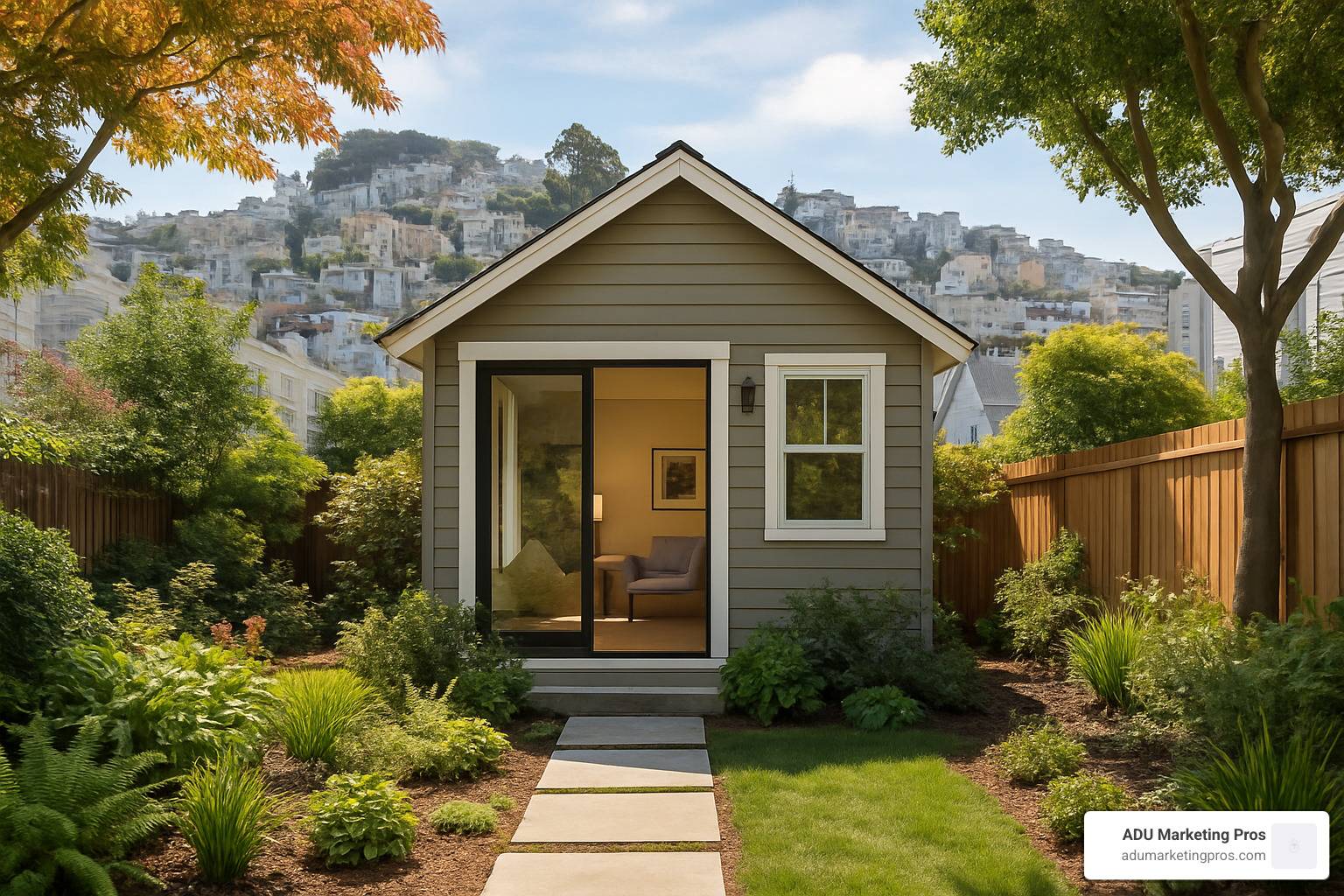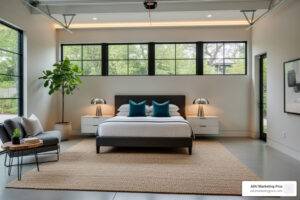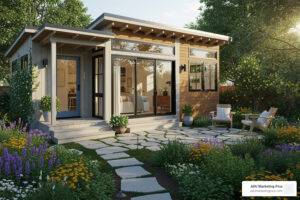The Housing Solution in Your Backyard
Granny flat San Francisco options are becoming increasingly popular as homeowners seek affordable housing solutions in one of America’s most expensive real estate markets.
Quick Answer: San Francisco Granny Flat Options
* Definition: Self-contained living units on existing residential properties (also called ADUs, in-law units, or backyard cottages)
* Types: Conversion (garage/basement), attached addition, detached structure, or Junior ADU (JADU)
* Cost Range: $250,000-$800,000 depending on size and type
* Permits: Required through SF Planning Department and Department of Building Inspection
* Rental: Long-term rentals allowed, short-term rentals (Airbnb) prohibited
Housing may be the biggest challenge facing the San Francisco Bay Area, and for solutions, many homeowners are thinking small. These compact secondary units provide much-needed housing while helping property owners generate additional income or accommodate family members.
Since San Francisco’s Accessory Dwelling Unit program became available citywide in 2016, hundreds of new units have been planned, with the potential for thousands more as homeowners use available backyard spaces. Recent state laws have streamlined the permitting process, reduced parking requirements, and eliminated many traditional barriers to ADU construction.

Granny Flat San Francisco: What & Why
A granny flat San Francisco is a practical housing solution that’s changing how Bay Area families live. These accessory dwelling units (ADUs) create independent living spaces on the same property as your main home, whether converted from existing spaces, added as extensions, or built as standalone structures in your backyard.
Multigenerational living has become a driving force behind the ADU movement. As housing costs climb in the Bay Area, families are finding smart ways to stay together while maintaining independence. The financial benefits are compelling:
- Equity boost – Well-designed ADUs can increase property value by 30-40% in California markets
- Rental income – Monthly rents typically range from $2,000-$3,000
- Aging-in-place – Many homeowners move into their ADU and rent out the main house
- Climate-smart infill – ADUs reduce sprawl and transportation emissions
- Transit-oriented development – San Francisco’s public transportation makes car-free ADUs practical
“A look at the initial impact shows that hundreds of new units are being planned for San Francisco, and fully utilizing backyards and other available spaces could mean thousands of future residences for California’s coastal cities,” notes a BuildZoom study on ADU development.
Key Benefits at a Glance
The advantages of adding a granny flat San Francisco include remarkable flexibility as these spaces evolve with changing needs, passive income potential, family proximity with personal boundaries, significant property value increases, and community benefits like increased housing supply and aging-in-place options.
Who Can Add One?
Most San Francisco property owners can add a granny flat San Francisco:
- Single-family lots: Typically 1 ADU plus 1 Junior ADU
- Multi-family buildings (4 or fewer units): 1 ADU plus 1 detached ADU
- Larger multi-family buildings (5+ units): Unlimited ADUs under the Local Program
- Junior ADUs (up to 500 sq ft): Require owner occupancy in either the main home or JADU

Laws & Programs: Local, State & Hybrid Pathways
San Francisco offers three distinct ADU programs, each with different advantages:
San Francisco’s Three ADU Programs:
-
Local Program: Offers flexibility with planning code waivers but may subject ADUs to rent control rules. Particularly generous for multi-family buildings.
-
State Program: Provides streamlined review with 60-day ministerial decisions. Follows California state laws rather than local rules.
-
Hybrid Program: Combines state-level streamlining with local flexibility, allowing one ADU plus one JADU while avoiding most planning code requirements.
| Feature | Local Program | State Program | Hybrid Program |
|---|---|---|---|
| Review Time | Discretionary | 60-day ministerial | 60-day ministerial |
| Rent Control | May apply | Generally exempt | Generally exempt |
| Eviction Restrictions | Yes (5-10 years) | No | No |
| Density Limits | More flexible | Stricter | One ADU + One JADU |
| Code Waivers | Available | Limited | Limited |
All programs require ADUs to be used for long-term housing—no short-term rentals allowed.
Zoning & Placement Rules
Detached ADUs need to fit within the buildable area of your lot, typically with 4-foot setbacks from property lines under the State Program. Height limits usually range from 16-20 feet. Street trees are required for every 20 feet of street frontage.
ADUs that use planning code waivers may fall under rent control agreements according to Section 37.2(r).
How Many Units Can You Add?
The number depends on your property type and program choice:
- Single-family homes: Typically 1 ADU plus 1 JADU
- Multi-family buildings under State Program: Convert up to 25% of existing units into ADUs
- Multi-family buildings (5+ units) under Local Program: No limit on ADUs
- Buildings undergoing seismic upgrades: Possibility of unlimited ADUs
More info about ADU Permits California
Plan & Build: Design, Cost, Timeline, Financing
Design Options
San Francisco welcomes several types of ADUs:
- Conversion ADUs: Transform existing spaces like garages, basements, or storage areas
- Attached ADUs: Extend your current home with a connected addition
- Detached ADUs: Create a standalone structure in your backyard
- Junior ADUs (JADUs): Transform up to 500 sq ft within your home

Consider San Francisco’s pre-approved ADU plans to save time and money.
Cost Considerations
Building a granny flat San Francisco typically costs:
– $350-$900 per square foot in the Bay Area
– $250,000-$500,000 total cost on average
– $350,000-$390,000 for a standard unit in San Francisco
– Up to $800,000 for high-end finishes
Conversion projects generally cost less than new construction. Property taxes will increase only on the ADU’s added value through a blended assessment. Don’t forget to update your insurance coverage.
Timeline Expectations
The typical ADU timeline includes:
– Planning and design: 1-3 months
– Permits: 2-6 months (faster with State/Hybrid Programs)
– Construction: 3-9 months
– Final inspections: 1 month
Most projects take 12-18 months from concept to completion.

Step-by-Step Permit Checklist
- Complete a site feasibility assessment
- Post a notice in your building (Local Program)
- Prepare construction documents
- Submit application through the city’s online portal
- Address required changes
- Receive job card from Department of Building Inspection
- Schedule required inspections during construction
- Obtain certificate of completion
Budget Breakdown & Funding Options
Your budget should include soft costs (15-25%), site preparation, construction, finishes and fixtures, and landscaping.
Financing options include:
– Home Equity Line of Credit (HELOC)
– Cash-out refinance
– Construction loans
– CalHFA ADU Grant Program (up to $40,000 for pre-development costs)
– Local assistance programs
Space-Savvy Design Ideas
Maximize your ADU with multi-functional furniture, universal design elements, solar-ready roofing, indoor-outdoor flow, vaulted ceilings, built-in storage, and energy-efficient appliances.
For more detailed information about construction costs, visit ADU Construction Cost.
Troubleshooting & Ownership Challenges
Common Challenges and Solutions
San Francisco’s hills can complicate construction. Consider pier foundations, split-level designs, or strategic retaining walls for sloped lots.
Utility connections often present complications. Assess water and sewer laterals, plan for electrical panel upgrades, and obtain special permits for gas line extensions before breaking ground.
In San Francisco’s busy construction market, book your preferred builder 3-6 months in advance. Consider prefab or modular options to reduce construction time.
Maintain good neighbor relations by informing them about your plans before construction begins. Address concerns about privacy, shadows, or noise proactively.

Legalizing Unpermitted Units
Many San Francisco homes have existing unpermitted in-law units. Bringing these spaces into compliance can be more cost-effective than building from scratch. Consult the Department of Building Inspection’s Legalization of Unauthorized Units Checklist.
Be prepared for upgrades to meet current building codes, especially electrical, plumbing, and egress requirements. San Francisco’s Unit Legalization Program offers certain code flexibility to help homeowners.
“The legalization process, while sometimes challenging, offers a path to increase property value and eliminate legal liability,” notes the San Francisco Planning Department.
Insurance Considerations
Standard homeowner’s policies typically don’t fully cover ADUs, especially rentals. Contact your insurance carrier before construction begins to discuss options. Consider increasing liability coverage if you plan to become a landlord.
Document all improvements and keep receipts for insurance purposes and potential tax benefits.
Renting & Compliance Essentials
Rental Rules
San Francisco has clear guidelines for renting your ADU:
- Your granny flat must be used for long-term housing only (30+ days)
- Short-term rentals like Airbnb are prohibited
- If built under the Local Program, file a declaration with the Rent Board
- Fair housing laws apply when selecting tenants
- Occupancy limits are typically two people per bedroom plus one additional person
- Rent control may apply depending on which ADU program you used
“ADUs are ineligible for the Short-Term Rental program,” the San Francisco Planning Department emphasizes.
Current market rates for granny flats in San Francisco:
– Studio ADUs: $2,000-$2,400 monthly
– One-bedroom ADUs: $2,400-$2,800 monthly
– Two-bedroom ADUs: $2,800-$3,500 monthly
Create a clear lease agreement outlining maintenance responsibilities, modification rules, and guest policies.
For more detailed information about permit requirements across California, check out More info about ADU Permits California.
Frequently Asked Questions about Granny Flat San Francisco
What’s the fastest way to get a permit?
The State and Hybrid Programs offer streamlined 60-day ministerial review processes. Using pre-approved plans can save weeks of back-and-forth with planning officials. Ensure your application package is complete and accurate the first time, or consider hiring a permit expediter. For complex projects, request a Permit Review Roundtable early in the process.
Can I Airbnb my San Francisco granny flat?
No. San Francisco requires ADUs to be rented for periods of 30 days or longer. Short-term rentals like Airbnb are explicitly prohibited. This restriction ensures ADUs contribute to solving the housing crisis by providing stable, long-term housing options for residents. Long-term rentals can provide more consistent income without the management headaches of vacation rentals.
Will my property taxes skyrocket?
Your tax bill will increase, but not dramatically. California uses a “blended assessment” method for ADUs, where only your new ADU gets reassessed at current market rates while your existing home maintains its original tax basis.
For example, if your home is currently assessed at $800,000 and you add a $200,000 ADU, only that $200,000 addition would be subject to current property tax rates (typically around 1%), adding approximately $2,000 to your annual tax bill.
This approach offers a significant advantage, especially for long-time homeowners who benefit from Proposition 13’s caps on property tax increases. Many homeowners find that rental income from their ADU more than covers this tax increase.
Conclusion
The granny flat San Francisco movement is a thoughtful response to our city’s housing challenges. These compact spaces create homes where none existed before, offering remarkable versatility for families and homeowners.
ADUs provide housing for aging parents or adult children, generate rental income, and contribute to our community’s housing supply. The return on investment can be substantial, whether measured in property value or the ability to keep family close while maintaining independence.
The journey from concept to completed cottage requires careful planning through permitting pathways, design choices, and budget management. The process typically takes 12-18 months, but the long-term rewards are worth the effort.
These innovative small spaces will likely become even more integral to San Francisco’s housing landscape as regulations evolve and construction methods become more efficient.
At ADU Marketing Pros, we connect homeowners with the Bay Area’s finest ADU construction and architecture firms. While we don’t build ADUs ourselves, our specialized marketing solutions help quality builders showcase their expertise to homeowners ready to start their ADU journey.
Success starts with expert guidance—whether you’re a homeowner exploring options or a construction professional looking to grow your ADU business. The right partnership can make all the difference in creating a backyard cottage that serves your needs for years to come.
As San Francisco evolves, these small but mighty dwellings will play an increasingly important role in creating a more inclusive, housing-rich city—one backyard cottage at a time.




